FÉLIX MOREL is a musician and collage artist based in Montréal. He has played drums in a number of bands including Fly Pan Am, Panopticon Eyelids, Les Enfants Sauvages and Et Sans. He has designed album covers for Acid Mothers Temple, Red Mass, Drainolith and Bernard Gagnon among others. His collages, as well as his drawings, have appeared in various underground comic anthologies and magazines including aMAZEzine, Mr. Swiz, 106U, Alarm Press and Kolaj. His work is a mix of technological, erotic and gory imagery, often in the form of album sleeves for imaginary records. Composed of precisely arranged magazine cuttings, his collages picture colourful and surreal fantasies fuelled by trance states, the obsessive and meticulous act of cutting, and his record collection. Morel is self taught both in music and the visual arts. He sat down recently with
B O D Y Art Editor Jessica Mensch to talk about his collage art, album covers, music and what it was like working as a tabloid art editor.
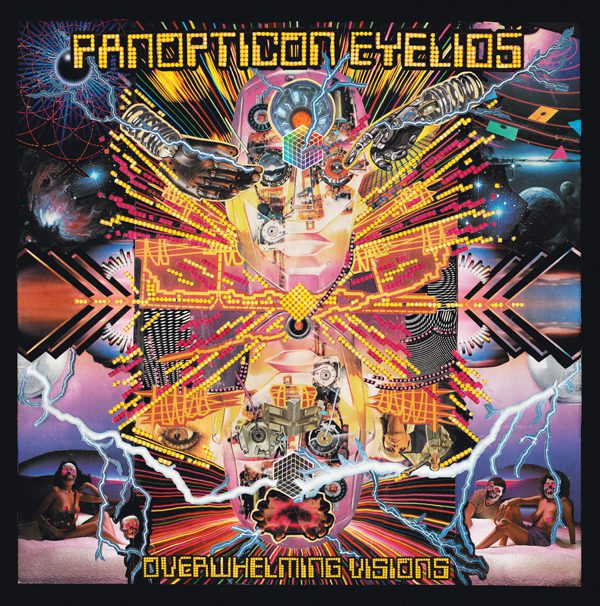
B O D Y: I’m listening to the latest Panopticon Eyelids record right now, it’s great!
Félix: Thank you very much, we worked hard on it.
B O D Y: I heard that your early collages were the size of record sleeves.
Félix: Well, the first 4 collages I ever did just happened to fit on an LP sleeve, and so I had the idea of gluing them onto record jackets to create imaginary/fake records. I wanted them to be a total thing, with fake band names and album and song titles. I scratched that idea. I have a lot of good ideas and concepts but I’m no Christian Marclay. Furthermore, I have no need to do that as I make REAL album covers now. I’ve been obsessed with record covers since discovering music. The earliest LP sleeves I can remember seeing were in my parents very small vinyl collection: Peter and The Wolf, Nana Mouskouri and a Bachman Turner Overdrive compilation with a gold embossed logo.
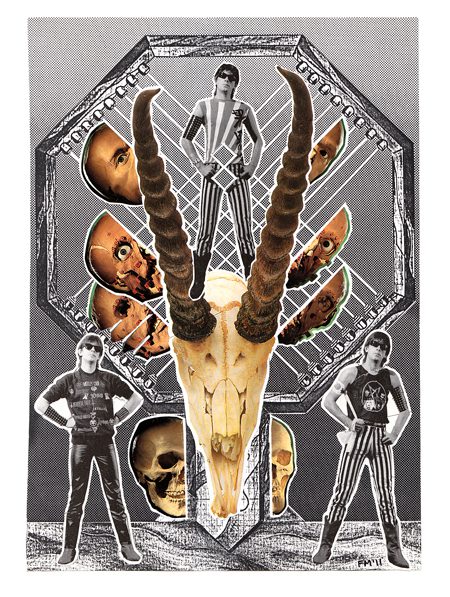
B O D Y: Do you see the album cover and the music as separate entities?
Félix: Yes. I remember owning and looking repeatedly through Roger Dean’s Album Cover Album book when I was a teenager, and trying to imagine what kind of music would be inside the sleeves. As a record collector and a curious person, I often buy cheap unknown LP’s for the cover. It rarely pays off. I LOVE the covers, but generally the music sucks. The real magic is when a cover and the music are working together symbiotically, when you couldn’t imagine the record with another artwork.
B O D Y: Can you name one?
Félix: Let me think… Obvious answer would be some heavy metal covers. The music is so codified that you need the bad ass lightning, skulls and bones’ cover or it would feel wrong. I find the first self-titled Santana cover by Lee Conklin (with the African warrior lady morphing into a tiger’s face) to be very fitting – psychedelic while being tribal and rootsy at the same time. Airbrushed space disco covers are pretty spot on most of the time. I couldn’t think of a better aesthetic for those records. I hope to achieve this symbiosis when I do a cover, that’s why I insist on getting the music when I start working on a collage for a band.
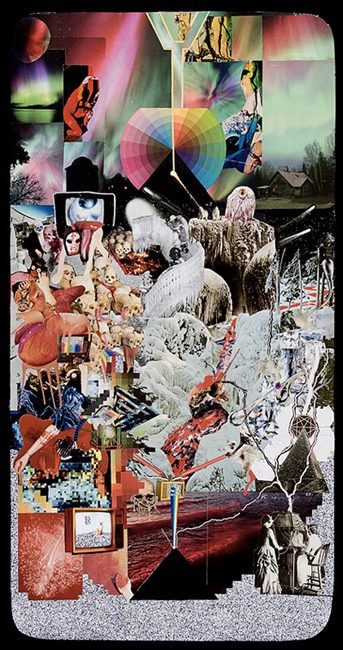
B O D Y: I know that you make all your collages by hand without the use of digital editing programs like Photoshop (which boggles my mind!). Can you tell me about that?
Félix: Images on paper, X-Acto knife or scissors, and glue. That’s it. I’ll occasionally use paint, Sharpie, silver ink, liquid paper, and tape to camouflage elements. A lot of people have told me they thought I made my collages on the computer, and I took that as a compliment. Maybe it’s because I use a lot of early computer graphics imagery that’s been printed on glossy paper, or the fact that I carefully place the cuttings so they blend into each other seamlessly. A lot of collage art has an ‘old-timey-Dada’ style to it that I am not into using for my own work. I like to create the illusion that my works are NOT collages. This is also why I really should make more prints – when they are blown up big you can see the glue, X-Acto knife cuts, hair, some finger grease . . . stuff like that.
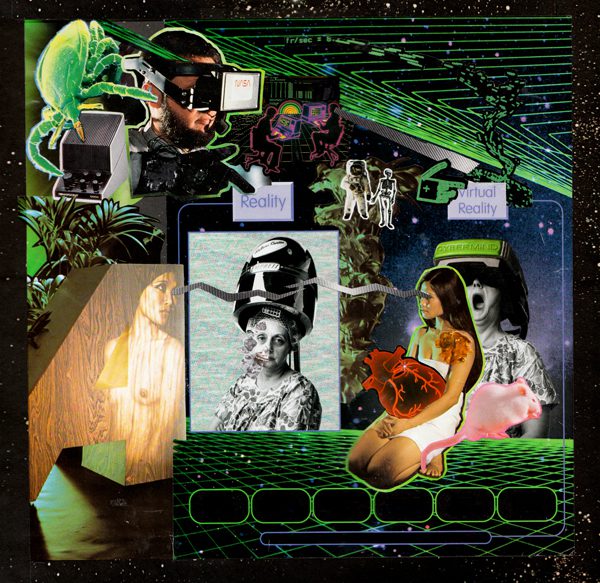
B O D Y: Why don’t you want your images to look like collages? And wouldn’t seeing all that glue and stuff tip people off that they in fact are collages?
Félix: What I meant is that I don’t want them to look like old-school ripped paper collages. EZ Retro Nostalgia Via Old Catalogue Collage. Carefully laid out masking tape and crud. It’s nothing against people who do that, I love a lot of work in this style. John Olson (of American Tapes label, Wolf Eyes and at least 100 other musical acts) uses the old school punk ripped paper technique and twists it into his own language of sharpie doodles, gore and texture. His collages are instantly recognizable and I love them. I used that technique for “Moisture Whip” and “Shock Proof”, and from time to time on gig posters. But, I love optical illusions and I get off on finding images that are approximately to scale and colour coordinated. I am not trying to hide the fact that they are collages at all. I am not even that careful when I apply the glue. I don’t know how contradictory that is but I like a bit of the illusion and a bit of the crud in my work. Best of both worlds.
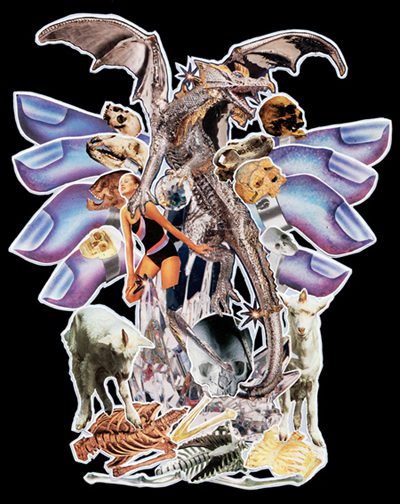
B O D Y: When I look at your work I’m compelled to piece together some kind of story or scenario. I feel like I’m seeing multiple or simultaneous plot lines that are woven together in time but exist in different dimensions. Do you see your work that way?
Félix: That is pretty spot on! For 2012: Dystopian Clone Zone I wanted it to look like some lost 80’s apocalyptic Sci Fi flick poster or VHS cover. You know, the ones where the main illustration is a collage of different scenes from the movie, all arranged around a central character. In Clone Zone, everything is making sense in its own time-bending universe. I tried to have an internal logic to all the cuttings in the piece so that everything has a reason to be there (but only I know why). I guess subconsciously the watcher can get that feeling of logic even if the imagery is surreal. That is perhaps what I meant earlier by not wanting my work to look too much like a collage. Even if my work is surreal, it’s not abstract or random.
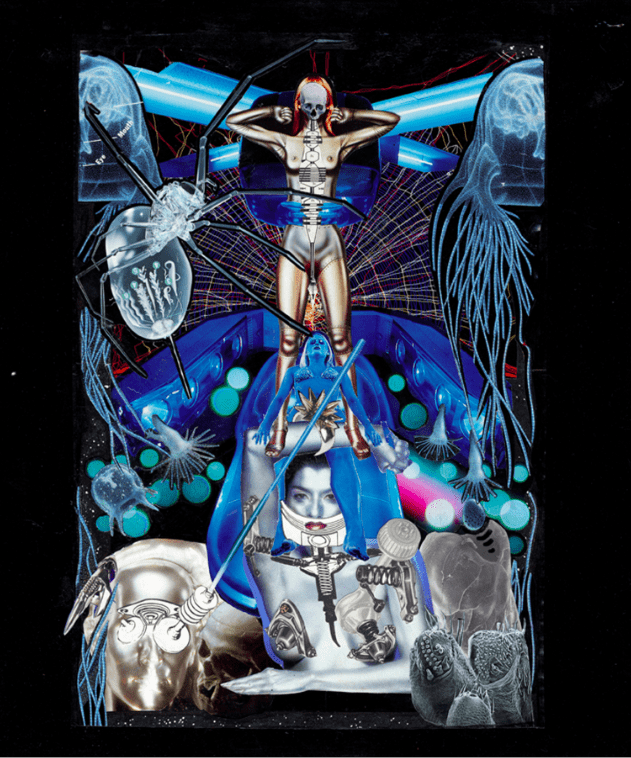
B O D Y: Right. Wow.
Félix: Having a theme or concept for the collage also helps me organize the chaos that could result. I have such a big bank of rad images that I could easily slap something together on a page and have a good looking finished piece . . . But I choose to go the complicated way.
B O D Y: Your work is visually dense.
Félix: I have a predilection for worked over imagery, that you can lose yourself in. My first psychedelic art experience was looking at the Robert Venosa print, Astral Circus, while in a shop, on acid for the first time. I later bought the print and had it in my basement room on the laundry room door. I couldn’t stop looking at it. I try to recreate that psychedelic feeling in my collages and sometimes I have to stop myself from adding more. That was the case for Snuff Chanel, I kept adding more and more to it and at some point I had to take a step back and say: “OK, enough crystal mountains around the unicorns. Enough Videodrome references. You are done”.
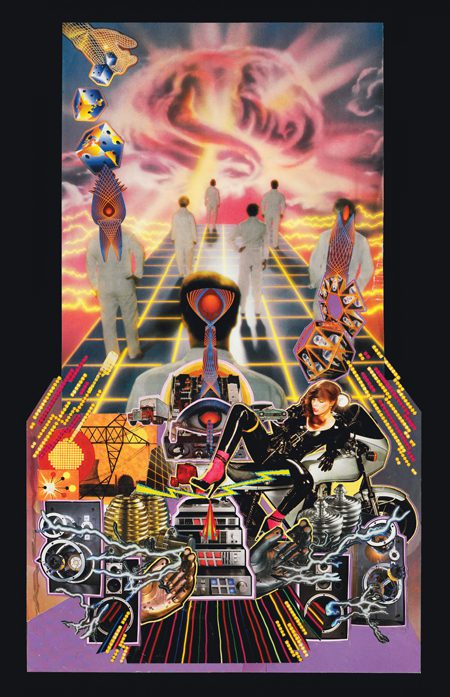
B O D Y: Heheh. I know that you worked for a Quebec tabloid in their imaging department.
Félix: Haha, inside information. Yes, I worked for four years at the Hebdo Litho printing plant. I worked on the infamous police tabloid, HEBDO POLICE, CRIME ET PASSION and SEXE ET HUMOUR. My job was to make sure the colours where tight for picture spreads. They often accompanied crazily titled articles such as: Copain Fou De Rage D’Amour Décapite Sa Blonde Dans Le Garage. We were also doing ALLO VEDETTES and other ‘celebritie’ weeklies, as well as a whole lot of neighbourhood newspapers. I did all the colour registration on every paper edition of Vice Magazine when it was first called The Voice of Montréal. They had the same sales agent as the crime and sex newspapers we worked for – that made a whole lot of sense to me. Fun times. I used to have a bunch of original colour separation films from some of the sex newspapers. I had the intention of doing something with them in the future. Got rid of those for some reason. And to be clear, I was working at the pressing plant photographing the final documents in the dark room, doing the registration layout on the light table, and plating the end results. Really minor adjustments at most, nothing very creative. I wasn’t working for Hebdo Police, I wish! Reading the articles in those tabloids you could tell they were having fun cranking out an issue every week, going on a sleazy writing rampage, coming up with all sorts of evil/sexy bullshit just to have the page count. I still kick myself in the butt when I think that I could have kept every issue of those newspapers. Some of the articles were hard to believe, – really crazy out there stuff!
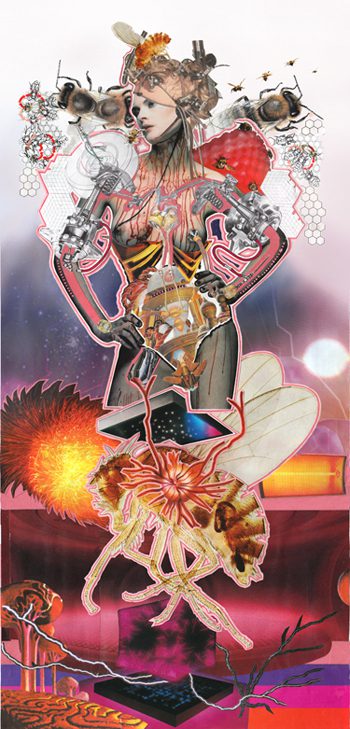
B O D Y: I heard you cut everything out by hand.
Félix: Yes, X-Acto knife and Rubylith. Old school style. I LOVED doing the Rubylith on weird jobs when I had a shit load of Rubylith tape and Rubylith marker corrections to do. I actually left just when most of the jobs where coming in on films – all registration perfect out of a computer printer. When that happened I asked my boss if I could work on all the weird Chinese, Indian and Egyptian newspapers so I could use the dark room and my X-Acto knife more. I got all my skills there for sure. Never cut myself except on the tape dispenser. I could go on talking about my days at the printing shop… weird crew and ambiance…
B O D Y: Please do!
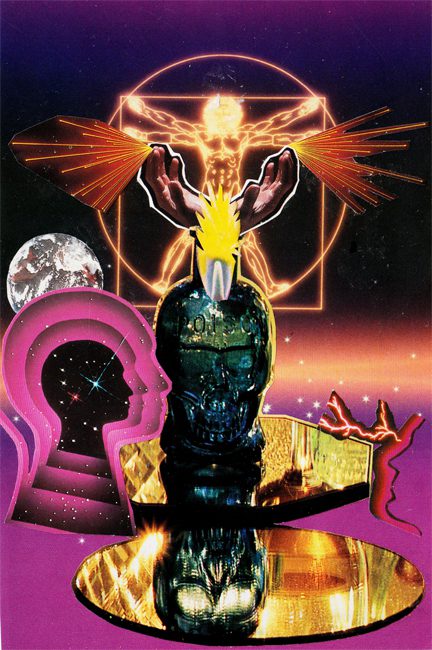
Félix: Well my boss Jean had a tracheotomy, so everything he said – every dirty joke, serious work request or laugh would sound like a lo-fi robot. And he looked like a bad ass Vietnam vet/biker with a French (from France, not Quebec) accent. Cool guy. The rest of the gang consisted of Carlos, a cool Peruvian dude who played percussion in Orchestra Panbiche, and two other grumpy, sad and bitter old school guys who used to work at Journal de Montréal back when they still had to put every lead letter down one after the other. They were burnt out on the job and just walking through the motions, leaving me all the interesting work to do. In the time I was there two different guys got their hands stuck in the huge paper press cylinders. I didn’t see it because our department was in another part of the building, but apparently it was really gory!
B O D Y: Yikes. Were you making collages before you worked for Hebdo Litho?
Félix: No. But I did more than twenty black and white drawings that are collages in a way. I took photocopied forensic science encyclopedia entries, medical drawings and photos, as well as sacred imagery, retraced them all on translucent paper, and layered them. I did most of these drawings for a comic I made titled, On The Inhalation Of The Vapour Of Ether In Surgical Operations, for the Mutants issue of 106U Magazine curated by Eric Braün. At that time I was living with an underground comic book artist and was exposed to a lot of the extremes of this art form as well as the characters in that scene. I think it rubbed off on me a little bit in these drawings. It was a thematic issue about mutations, and I approached it from a literal, medical point of view. No censorship.
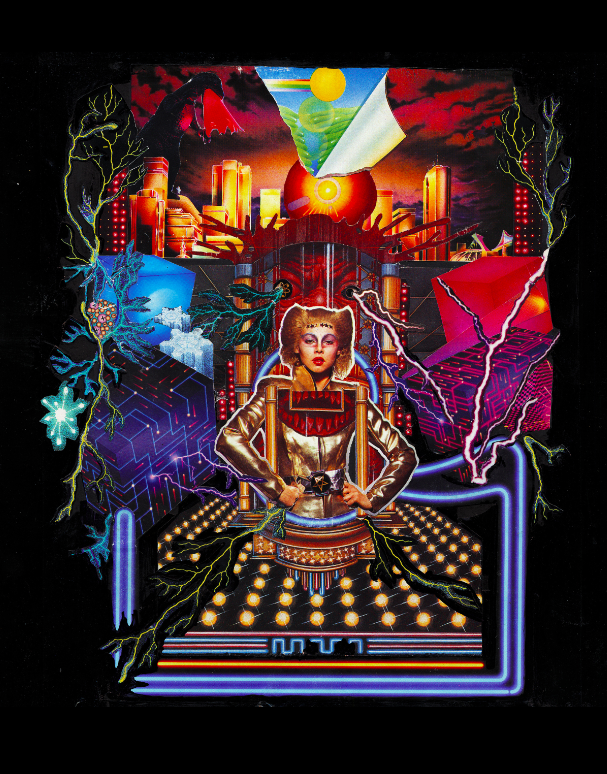
B O D Y: What draws you to depicting sci fi narratives?
Félix: That’s a big question… I have always been interested in the ‘other’, the weird, the outsider, since I was young. My favourite library books as a kid were old books about the Future, you know, ‘Year 2000’, books with flying cars, sky tunnels, giant hanging gardens, neon everywhere . . . I remember in the 80’s going to Pinball parlours in Baie St-Paul with my older brother Simon, and being entranced by the noise and the graphics of those machines. Tacky, retro-futuristic aesthetics are deep in my subconscious. I just love the look of it and I feel legit using it since I grew up on it. My collages are a distillation of what I like, and I think Science-Fiction is often the appropriate environment for my visions to live in.
B O D Y: Is there a relationship between making music with your band Panopticon Eyelids and your art practice?
Félix: In a literal sense, yes. I did a lot of cover artwork and posters for Panopticon Eyelids over the years. Both the band and my collages juxtapose contrary but strangely fitting imagery/notes/musical
styles. They both belong to a tradition of open minded, exalted attitudes towards art, where the journey itself will bring you to the final statement. You don’t need a map, a musical chart or a final visual concept to get to where you want, you just have to concentrate, dig deep inside and edit/listen/improvise a lot to find the comfort zone. If it doesn’t look/sound right, don’t jam it out/glue it in.
–Jessica Mensch